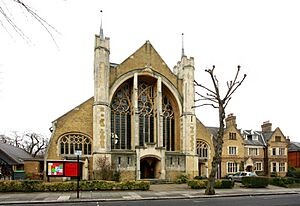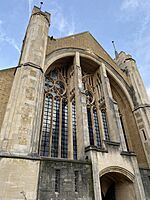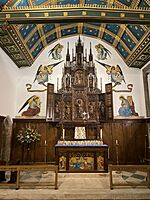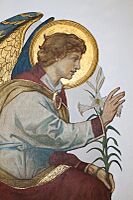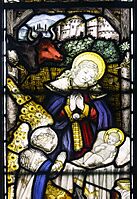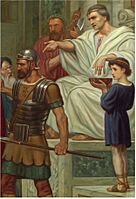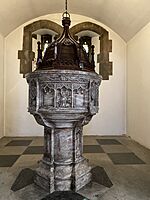St Peter's Church, Ealing facts for kids
St Peter's Church, Ealing, is an Anglican parish church in North Ealing, London. It is famous for its beautiful and unusual architecture. The famous poet Sir John Betjeman once called it a Victorian church that people could be proud of.
The building is a Grade II* Listed building, which means it is a very important and protected historic site. It is known for mixing two styles of design: Arts & Crafts and late-Victorian Gothic. Today, the church holds regular services and is also a busy center for community events.
Contents
History and Design
Notable for its unusual fusion of free Gothic style used in a highly original manner, St Peter’s occupies no small place in the last great age of church building
- — Sir Roy Strong, historian
A New Church for a Growing Town
St Peter's was built because the area of North Ealing was growing quickly in the late 1800s. It started as a mission church for Christ the Saviour Church, Ealing. The land for the new church was given by a man named John Clark Record.
Before the current stone church was built, a simple iron church stood on the site for 10 years. That first church was named after St Andrew. When it was time to build the new, permanent church, there was a small problem. A nearby Presbyterian church was also being built, and they also wanted to use the name St. Andrew.
To be friendly and avoid an argument, the church leaders decided to change their plans. They chose St. Peter as the new name instead of the "Scottish" saint, St. Andrew.
A Unique Building
The new church was built between 1892 and 1893. The first design was created by John Dando Sedding, a famous architect. Sadly, Sedding died before the church was finished. His student, Henry Wilson, took over and completed the project.
The first stone was laid in 1893 by Princess Helena, who was the third daughter of Queen Victoria. The church was officially opened in the same year by the Bishop of London, Frederick Temple.
Architects at the time loved the design. The Builder magazine called it "a piece of real originality." The outside of the church is very striking. It has a long, steep roof and two small towers at the front. Between the towers is a very large and beautiful window with detailed stone patterns called tracery.
Inside, the church feels surprisingly light and open. This is because many of the windows have clear glass instead of stained glass, and the main hall, or nave, is very wide and tall. Henry Wilson designed the beautiful flowing patterns on the brass panels of the main doors.
Art and Memorials
Over the years, many beautiful items were added to the church.
The Lady Chapel War Memorial
A smaller chapel, called the Lady Chapel, was added in 1913. After World War I (1914-1918), it was decorated to serve as a war memorial. This was to remember the soldiers from the community who had died in the war. The project was led by the vicar, Bertram Kite, in memory of his own son, Ralph, who was killed in France.
The chapel features:
- An oak reredos (a decorative screen behind the altar) designed by Cecil Greenwood Hare.
- Beautiful wall paintings of angels above the altar, created by the artist Henry Charles Brewer.
- Altar rails given by a local campaigner, Isabella Holmes, in memory of her son.
The chapel was carefully restored in 2022.
Other Special Features
- The Font: The stone font used for baptisms was designed by Leonard Shuffrey, an architect who was a member of the church. It was dedicated in 1911.
- Stained Glass: Although a full set of stained glass windows was planned, only six were ever made. They were designed by Walter Tower of the famous Kempe and Co company.
- Christ Before Pilate Painting: In the south aisle, there is a large painting by Edward Arthur Fellowes Prynne. He was an artist who lived nearby. The painting was given to the church by his wife after he died in 1921.
The Church Community Today
St Peter's is an active church with services on Sundays and during the week. It is also a hub for the local community.
The church hosts many groups and activities, including:
- A walking group
- A book club
- A Sunday choir and junior church
- An organ recital series
- Support for the Ealing Churches Winter Night Shelter
Local schools also use the church for concerts and Christmas carol services.
Notable People Connected to St Peter's
Over its long history, many interesting people have been connected to the church.
- Bertram Kite (Vicar from 1916–1939): Before coming to Ealing, he was the Dean of St David's Cathedral, Hobart, in Tasmania, Australia.
- William Taylor (Vicar from 1991–2000): He later became the Dean of Portsmouth Cathedral.
- Morris Maddocks: He was a curate (an assistant priest) at St Peter's in the 1950s. He later became a bishop.
- Isabella Holmes: A well-known social reformer who donated the altar rails in the Lady Chapel. Her half-sister, Margaret Ethel MacDonald, was married to the British Prime Minister Ramsay Macdonald.
- Henry Austin Dobson: The funeral for this famous poet and writer was held at the church in 1921.
Gallery
-
Detail from Edward Arthur Fellowes Prynne's painting Christ Before Pilate' at St Peter's Church, Ealing


